By Scott Smith | Contributing Editor
In the shooting industry it is rare that firearms get a second chance. Generally when they are “reissued” it is because the first version had issues and shooters remember the initial failure. This is not the case with the Ruger PC9 (Phone: 336-949-5200; Online: ruger.com).
In the early ’90s the first Police Carbine could not be manufactured fast enough. The first version was Ruger’s Police Carbine available in both 9mm and 40S&W using Ruger “P” series magazines. It seems when the Clinton Crime Bill hit is when the Police Carbine disappeared from the market. Last year it was rumored the PC9 would be resurrected and it was as the PC9.

Ruger’s PC9 with Truglo’s MSS and Streamlight’s HLG is ready for whatever you choose to use the carbine for.
Ruger could not have picked a better time to bring back their popular PC 9 because pistol caliber carbines are the hottest thing on the market today. Making the PC9 even more desirable is the interchangeable magazine wells that accept Ruger’s American Pistol, Security 9 or Glock 17 magazines. The PC ships with the Security 9 insert installed and the Glock insert in the box. The American Pistol insert is $29.95 from ruger.com. But I get ahead of myself, back to the PC 9.
The sample PC 9 arrived around the first part of May meaning I had good weather to test in. What I noticed after unpacking it was the weight is centered to the rear of the carbine. This greatly mitigates recoil and makes it easier to quickly transition from target to target. The box also contains stock three half-inch spaces to adjust the length of the stock to fit you. There are two Security 9 magazines to feed the PC9 as well as the Glock mag well insert. I noticed the Glock insert did not like my first generation magazines, but the latest version as well as those from ETS and Magpul functioned properly.
Thread Protector
I started perusing the carbine from the muzzle back. Immediately you notice the thread protector on the ½”X28 threads so you can install a muzzle brake or suppressor; provided you are not in one of the progressive controlled enclaves. Next is the fluted barrel 16.5-inch cold hammer forged chrome-moly barrel. This barrel should last you forever. Atop the barrel is the post style front sight. At the rear is a windage adjustable ghost ring sight which is adjustable for elevation and windage. Windage adjustments are gross adjustments not fine like you find with a peep sight. Out of the box the PC9 is being pretty much dead-on at 15 yards; I would not worry about making precise sight adjustments. Odds are better than average the PC will get used with a red dot or low power optic.
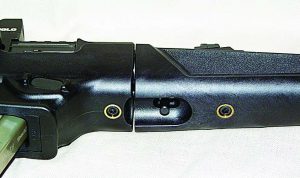
This small lever makes the PC9 unique among pistol caliber carbines; you can take it apart.
The front section of the stock like the butt stock is textured glass-filled nylon. I say front section because the PC 9 is a breakdown long gun. I say front section, because the PC9 is a breakdown carbine. Ensure the chamber is clear, lock the bolt to the rear and at the rear of the forearm is the lock; simply pull this to the rear while rotating the forearm and your carbine will fit in a backpack. At the front of the stock is a section of molded Picatinny rail to mount a light or laser, further enhancing the carbine’s usefulness. There is also a sling stud to attach your favorite sling and swivels.
Next up is the receiver. This houses the mag well, trigger group, mag release and bolt group. The magazine release and charging handle are ambidextrous; sorry the PC only ejects out the right side of the carbine. I did not notice brass bonking me in the face when shooting left handed. Ruger uses its proven 10/22 fire control group so you can easily trick out the trigger.
The butt stock is textured around the pistol grip just like the forearm. The texturing is aggressive without being too aggressive. The rear swivel mount is molded into the stock. You will notice a molded groove around the top of the stock. I would venture in the future that there will be an adjustable cheek piece like the American Rimfire to ensure proper eye/optic alignment. 2
First Impression
My first impression of the PC 9 was this is a heckuva a little rifle. The fit and feel are just right, it has pretty much all the features you need and you can add accessories of your choice. After spending time on the range with it, my opinion was: this is a fine piece of gear. It was accurate and it was reliable. Ruger calls the action “dead blow,” their version of a direct blowback system. Even with subsonic 147-grain target ammunition it ran flawlessly. When that was swapped out for hot +P+ ammunition, all you noticed was a bit more recoil. The tungsten dead blow weight kept the bolt action and recoil to a minimum.
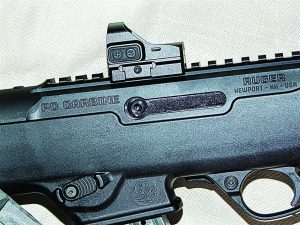
You can see in the bolt where you install the charging handle, the magazine release and the intensity buttons on Truglo’s TruTec Micro Subcompact Sight.
Initially I fired a couple hundred various types of ammunition through the PC to test its reliability and accuracy. It never missed a beat no matter what type of 9mm was fired. I give the PC9 two thumbs up for reliability. At 25 yards it was dead on and kept all the rounds inside the “0” zone of an IDPA target with iron sights. The black front was hard for me to pick up through the ghost ring; this old age thing. I hope there is a fiber optic front in the works.
When the $246 Truglo (Phone: 972-774-0300; Online: truglo.com) TruTec Micro Subcompact Sight (MSS) arrived, it was mounted and I selected my test ammunition to see what the PC 9 could really do. I also had a .357 Sig Compensator delivered from Lone Wolf Distributors (Phone: 208-448-0600; Online: lonewolfdist.com) to reduce muzzle rise. Once installed the brake proved it is well worth the $59.95 price.
With the PC9 all decked out, we come to a feature that sets this carbine apart from the rest of the market, the price $649. I have it on good authority you can find the PC9 at your favorite purveyor of fine firearms for $600. This means with TrucTec MSS, LWD muzzle brake and additional magazine insert we are all in for $959 at full retail. This means at full retail, you can have a complete carbine for far less than just about any other pistol caliber carbine on the market today.
Range Testing
Now that the PC9 was ready to run it was time to take it to the range. Truglo’s MSS mounted perfectly to the Picatinny rail on the receiver. The MSS is the latest in Truglo’s line of optics. This red dot has brightness controls on the side of the case. This makes it one of— it not the easiest—to adjust red dot on the market. The MSS runs on a single CR2032 battery and shuts the 3MOA dot off after four hours of non-use. Either the “+/-”will turn the dormant dot on, returning it to its previous setting, of which there are ten. A single battery should last you several months if not a year under normal use.
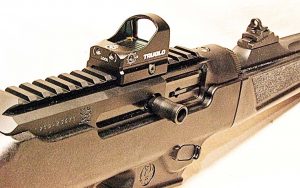
Here is the charging handle of the ride side of the bolt. You can see Truglo’s TruTec Micro Subcompact Sight (MSS) and the rear ghost ring rear sight.
Vertical adjustment is on the top of the case, while horizontal is on the side. Truglo marks the adjustment direction on each dial. This is a feature found on few mini red dots. There are no clicks when you adjust the point of impact. I do not consider this a big deal as I have not found the need to know how many “clicks” from the factory zero I adjusted. Once I have set them for my desired point of aim/impact, I rarely change zero. Over the years I have found when shooting red dots on pistol caliber carbines there is very little change in point of impact out to 75 yards. After that you find pistol caliber bullets drop dramatically.
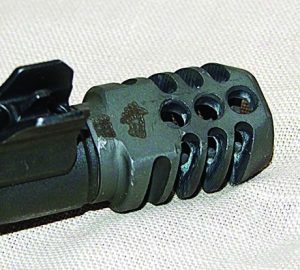
Lone Wolf Distributor’s .357 Muzzle Brake truly reduces muzzle rise for faster follow-up shots.
Test ammunition on hand was Black Hills (Phone: 605-348-5150; Online: black-hills.com) 115-grain full metal jacket and 124-grain jacketed hollow points, Federal (Phone: 800-379-1732; Online: federalpremium.com) 150-grain HST, 115-grain Syntech, Hornady (Phone: 800-338-3220; Online: Hornady.com) 125-grain HAP and 135-grain FlexLock, Sig Sauer (Phone: 603-610-3000; Online: sigsauer.com)115-grain full metal jacket and 124-grain V-Crown Hollow Points and Super VEL (Phone: 603-610-3000; Online: supervelammunition.com) 115-grain +P jacketed hollow points. This would be a good mix of ammunition for plinking, self-defense and competition.
Initially I used a mixed bag of leftover match ammunition to zero the Truglo MSS and PC9. I did not want to waste my supply of factory test ammunition. Once zeroed, I verified zero with Black Hills and Sig’s 115-grain full metal jacket loads. Only minor adjustments were needed and the carbine was dead on. After that I loaded magazines with five rounds of each load and fired them from the bench. I found the PC9 was pretty much dead-on with each load at both 25 and 50 yards. The HST was a bit low at 50; I think this was because of its weight.
Tight Groups
When fired from the bench all the loads were very accurate. At 25 yards five-shot groups, no matter the bullet weight or type, could be covered with a half dollar. At 50 yards all groups were less than two inches. With a magnifying optic I am certain this group size would drop. Even with a 3MOA dot your point of aim varies enough to increase your group. The most recoil as expected was from the 115-grain +P Super Vel; if you can call it recoil. What the +P did do was ensure the LWD muzzle brake had plenty of gas pressure to ensure there was virtually no muzzle rise. Offhand, as fast as you saw the dot you could accurately shoot.
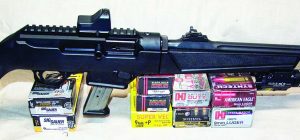
Ruger’s PC9 with test ammunition from Black Hills, Federal, Hornady, Sig Sauer and Super Vel. With premium ammunition the PC9 is wicked accurate.
Over the last several years I have found that quality ammunition with quality firearms outfitted with quality optics ensures accurate shooting. Gone are the days when there are wild fluctuations in accuracy from bullet type, weight and manufacture. If you shoot for lack of a better term duty or match ammunition your velocity and groups will be consistent in nearly all types of conditions. This is why I rarely report each bullet’s accuracy, preferring to give the average performance from magazines loaded with a mix of the test ammunition. At 50 yards from a rest the Ruger PC9 with Truglo’s MSS nine shot groups averaged about one and three quarter inches.
If I were going to use the PC9 for duty or personal protection I would add a quality light such as Streamlight’s (Phone: 800-523-7488; Online: Streamlight.com) TLR2 HLG. This 300 Lumen green laser light is ambidextrous with its momentary/constant on switch. This output will easily give you usable light out to 50 yards. Additionally you can also choose between light, laser/light or just having the laser on. This versatile light can be found online for under $340 and is worth every penny. Streamlight builds lights that will take a pounding and last forever. My first TLR which is now well over 15 years old is still in use today.
I chose the green laser because it is more visible in low light. Red lasers fade very quickly in any degree of daylight. I have found the green can be visible out to 25 yards on hazy winter days and at dusk/dawn. Realistically I would zero the laser for use across your house’s longest room or 15 yards. After this the laser spreads out, diminishing accuracy.
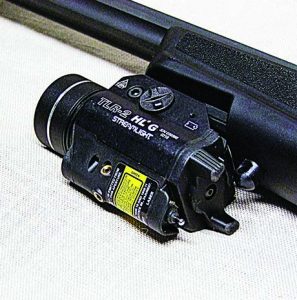
Close-up of the light toggle and the silver selector switch for the Streamlight TLR2 HLG. This light makes the PC9 a night fighter.
The only complaint about the PC9 is the magazine /pistol grip location. If it were possible, Ruger needs to make the pistol grip/magazine release more like that on ARs. This position is more conducive to smooth fast magazine changes without shifting your grip. That would be the only thing that keeps the PC9 from being a hugely popular pistol caliber carbine in USPSA. Other than that I have heard no complaints about the PC9. I know at least a dozen folks locally who have purchased them because you can install the Glock mag insert; they do not need to buy extra magazines. The PC9 is easy to shoot and fits virtually anyone and it’s hard to beat the price, especially when you can use Glock 17/19 magazines.
Ruger really hit it out of the park with the PC9. This carbine embodies a fun gun with a carbine that I would bet my life on. I have talked enough about shooting. Now I am off to the range to shoot the PC9. Everyone have a great summer. Take a neighbor or friend out and teach them to shoot safely, accurately and show them the fun you can have with a gun.



